Unit 9 When was it invented 教案(人教版九年级全册) (2)
- 格式:doc
- 大小:55.50 KB
- 文档页数:13
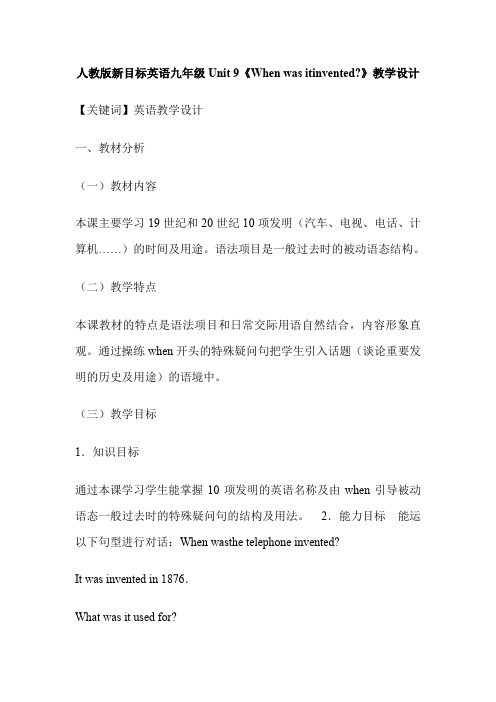
人教版新目标英语九年级Unit 9《When was itinvented?》教学设计【关键词】英语教学设计一、教材分析(一)教材内容本课主要学习19世纪和20世纪10项发明(汽车、电视、电话、计算机……)的时间及用途。
语法项目是一般过去时的被动语态结构。
(二)教学特点本课教材的特点是语法项目和日常交际用语自然结合,内容形象直观。
通过操练when开头的特殊疑问句把学生引入话题(谈论重要发明的历史及用途)的语境中。
(三)教学目标1.知识目标通过本课学习学生能掌握10项发明的英语名称及由when引导被动语态一般过去时的特殊疑问句的结构及用法。
2.能力目标能运以下句型进行对话:When wasthe telephone invented?It was invented in 1876.What was it used for?It was used for talking to people in other places.培养学生的观察、分析能力,快速反应能力,自学能力和用英语交流的能力。
3.德育目标教育学生爱学习,爱科学,开阔学生的思路,培养学生的创造精神。
(四)教学重点和难点重点:口头掌握本课核心句型When was the telephone invented?It was invented in 1876.What was it used for?It was used for talking to people in other places.难点:when引导被动语态一般过去时的特殊疑问句的结构及用法。
二、学习分析苏霍姆林斯基认为:“教给学生方法比教给学生知识更重要。
”建构主义是近年来介绍到我国的一种新兴教育理论,它认为知识不是通过教师传授得到,而是学习者在一定的情境即社会文化背景下,借助学习过程中其他人(包括教师和学习伙伴)的帮助,利用必要的学习资料,通过意义建构的方式获得的。
基于这样的认识,结合本课内容和初三年级学生的特点及学习经历,在教学中我侧重指导学生采用以下三种学习方法:1.合作学习法。
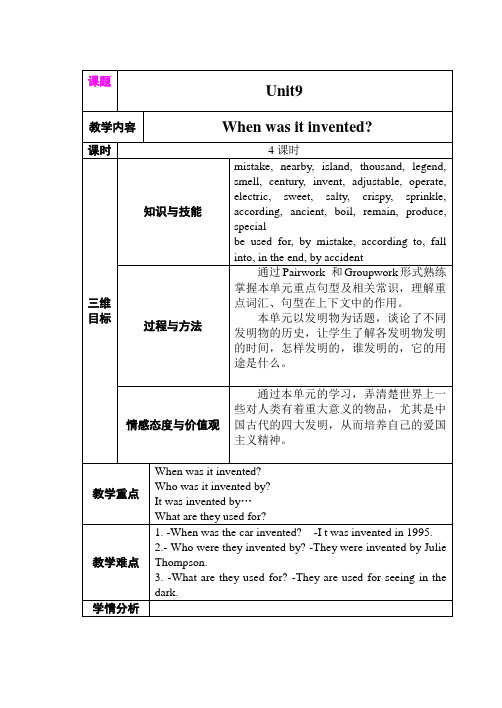
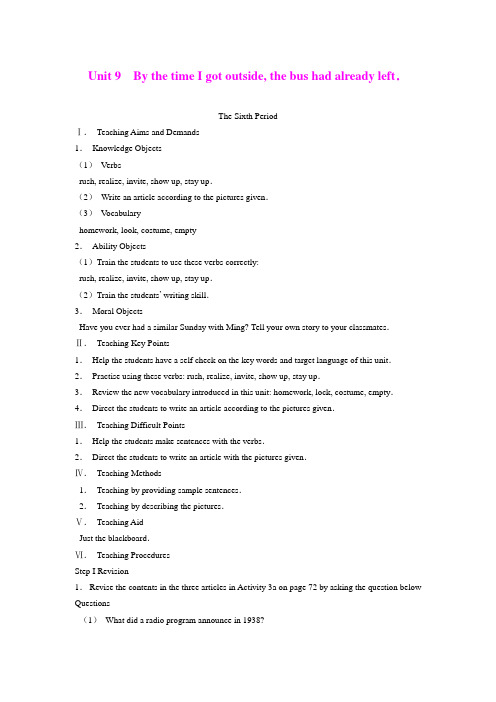
Unit 9 By the time I got outside, the bus had already left.The Sixth PeriodⅠ.Teaching Aims and Demands1.Knowledge Objects(1)Verbsrush, realize, invite, show up, stay up.(2)Write an article according to the pictures given.(3)V ocabularyhomework, look, costume, empty2.Ability Objects(1)Train the students to use these verbs correctly:rush, realize, invite, show up, stay up.(2)Train the students’ writing skill.3.Moral ObjectsHave you ever had a similar Sunday with Ming? Tell your own story to your classmates.Ⅱ.Teaching Key Points1.Help the students have a self check on the key words and target language of this unit.2.Practise using these verbs: rush, realize, invite, show up, stay up.3.Review the new vocabulary introduced in this unit: homework, lock, costume, empty.4.Direct the students to write an article according to the pictures given.Ⅲ.Teaching Difficult Points1.Help the students make sentences with the verbs.2.Direct the students to write an article with the pictures given.Ⅳ.Teaching Methods1.Teaching by providing sample sentences.2.Teaching by describing the pictures.Ⅴ.Teaching AidJust the blackboard.Ⅵ.Teaching ProceduresStep I Revision1.Revise the contents in the three articles in Activity 3a on page 72 by asking the question below Questions(1)What did a radio program announce in 1938?(2)What had happened by the time the authorities revealed the story was a hoax?(3)What did a reporter announce on April Fool’s Day?(4)What had happened by the time people realized that the story was a hoax?(5)What did a famous TV star once do on April Fool’s Day?(6)What was the ending of the last story?2.Ask three different students to read the articles.3.Dictate the following words:announce, convince, panic, authority, reveal, spaghetti, describe, hoax, thrill, flee/fled/fled.Step ⅡPart 1This activity focuses on vocabulary introduced in the unit.Focus attention on the box.Invite a student to read the vocabulary words at the top.You are asked to fill in the blanks with the words.In some cases, you may need to use another form of the word, for example, adjusting for tense or subject/verb agreement.Ask students to fill in the blanks on their own.Check the answers.Five students each reads a sentence, filling in the blanks.The rest of the students check their work.Answers1.realized 2.rush 3.stay up 4.invite 5.show upAsk students to make their own sentences with the words, preferably sentences that are meaningful.Move around the room.Collect a few students’ answers with mistakes on the blackboard.Along with the students’ help correct the mistakes.Suggested answers1.As soon as the bell rang, the students rushed to the playground.2.By the time he got to the office he realized that he had locked all his keys at home.3.Mr.Green invited his good friends to have a big dinner at home last Sunday.4.We have to finish the task before the boss shows up.5.Jack stayed up very late last night.He couldn’t wake up on time this morning.Step ⅢPart 2This activity provides writing practice using the target language.Have the students look at the seven pictures.Tell the children that the pictures are connected to each other in an order.Ask: What is happening to Ming?Get the whole class to read the instructions.Then ask the students to describe each picture in order.Write some useful sentences on the blackboard.For example, for the first picture, help the students to say Ming wakes up at 10:00 and thinks she is late for school.The sentences can vary.After describing each picture, ask the students to write a story about Ming’s day on their own.Walk around the room offering language support if needed.After a while, ask a few students to tell the class about Ming’s day.Let the rest of the class help correct the mistakes that they may have made.Tell them to exchange their articles with their partners and help each other correct the mistakes.Ask the students to rewrite their articles to make the articles perfect after class.A sample answerMing woke up at 10:O0 o’clock in the morning.She thought that she must be late for school.So she got up and rode a bike to school was empty.She was the only one there.Then she realized that it was Sunday.Her good friend, Han Mei, came to see her after she had got home.Ming told Hah Mei the whole story happened in the morning earlier.It made Han Mei laugh a lot.Ming went to her grandparents’house with her parents.They had dinner together and talked happily.Ming watched TV in the evening and she went to bed at 10:00.Step ⅣPart 3This activity focuses on the new vocabulary introduced in this unit.Call the students’ attention to the box.Have them look at the four groups of words.Get the students to read the instructions together.Ask them to circle the words that don’t belong in each group.The first one has been given as a model.Ask some students to tell their answers to the class.Check the answers with the whole class.Answers1.homework 2.lock 3.costume 4.emptyStep ⅤJust for Fun!This activity provides reading and speaking practice with the target language.Call the students’ attention to the cartoon pictures.Tell them to see what happens.Ask the students to read the sentences under the pictures together.Then ask the children what is, funny about this cartoon.Help the students to answer like this: The boy saw the clouds and he felt the rain long before he got home.He should have realized much sooner that he had forgotten his umbrella.Step ⅥSummaryIn this class, we’ve practiced using some verbs and we’ve written an article based on the pictures given.At last, we enjoyed a funny cartoon.All of you have done very well!StepⅦHomework1.Revise all the language points in this unit.2.Finish off the exercises on pages 36~38 of the workbook.3.Make another more sentence with each verb below, rush, realize, invite, show up, stay up.4.Rewrite the article.Step ⅧBlackboard DesignUnit 9 By the time I got outside, thebus had already left.Self checkThe Sixth PeriodAnswers to Activity 1:1.realized2.rush3.stay up4.invite5.show upSample answers to Activity 1:1.As soon as the bell rang, the students rushed to the playground.2.By the time he got to the office, he realized that he had locked all his keysat home.3.Mr.Green invited his good friends to have a big dinner at home lastSunday.4.We have to finish the task before the boss shows up.5.Jack stayed up very late last night.He couldn’t wake up on time thismorning.。
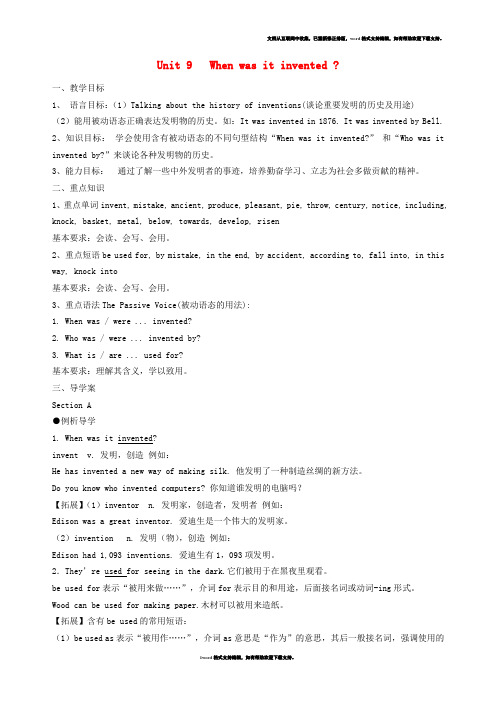
Unit 9 When was it invented ?一、教学目标1、语言目标:(1)Talking about the history of inventions(谈论重要发明的历史及用途)(2)能用被动语态正确表达发明物的历史。
如:It was invented in 1876. It was invented by Bell.2、知识目标:学会使用含有被动语态的不同句型结构“When was it invented?” 和“Who was it invented by?”来谈论各种发明物的历史。
3、能力目标:通过了解一些中外发明者的事迹,培养勤奋学习、立志为社会多做贡献的精神。
二、重点知识1、重点单词invent, mistake, ancient, produce, pleasant, pie, throw, century, notice, including, knock, basket, metal, below, towards, develop, risen基本要求:会读、会写、会用。
2、重点短语be used for, by mistake, in the end, by accident, according to, fall into, in this way, knock into基本要求:会读、会写、会用。
3、重点语法The Passive Voice(被动语态的用法):1. When was / were ... invented?2. Who was / were ... invented by?3. What is / are ... used for?基本要求:理解其含义,学以致用。
三、导学案Section A●例析导学1. When was it invented?invent v. 发明,创造例如:He has invented a new way of making silk. 他发明了一种制造丝绸的新方法。
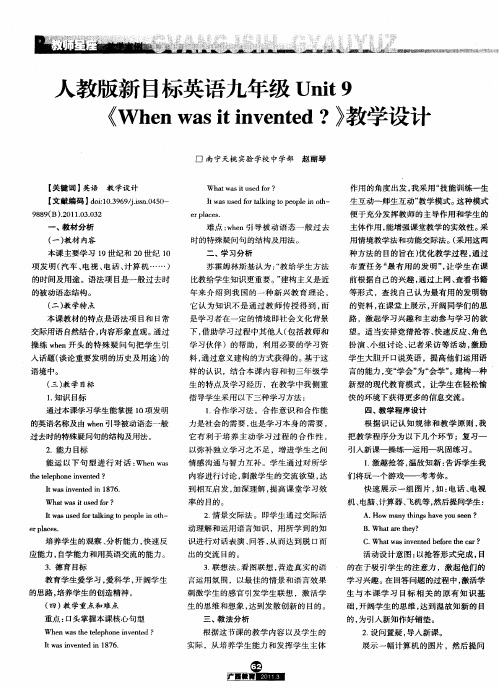
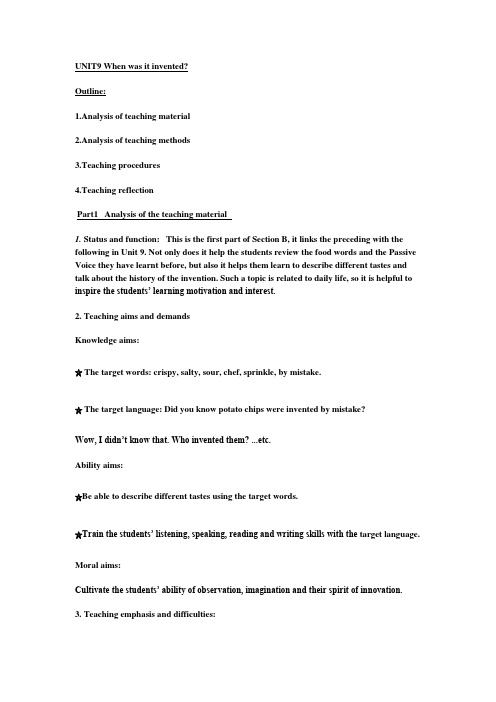
UNIT9 When was it invented?Outline:1.Analysis of teaching material2.Analysis of teaching methods3.Teaching procedures4.Teaching reflectionPart1 Analysis of the teaching material1. Status and function: This is the first part of Section B, it links the preceding with the following in Unit 9. Not only does it help the students review the food words and the Passive Voice they have learnt before, but also it helps them learn to describe different tastes and talk about the history of the invention. Such a topic is related to daily life, so it is helpful to inspire the students‟ learning motivation and interest.2. Teaching aims and demandsKnowledge aims:☆ The target words: crispy, salty, sour, chef, sprinkle, by mistake.☆ The target language: Did you know potato chips were invented by mistake?Wow, I didn‟t know that. Who invented them? ...etc.Ability aims:☆Be able to describe different tastes using the target words.☆Train the students‟ listening, speaking, reading and writing skills with the target language. Moral aims:Cultivate the students‟ ability of observation, imagination and their spirit of innovation.3. Teaching emphasis and difficulties:Important pointsThe target words and language.(According to the English syllabus and the language structures in this lesson.)Difficult points:The listening practice and correctly express the history of the invention.(According to the teaching prediction and the students‟ cognitive level)Part 2 Analysis of teaching methods1. Teaching methods:“Task-based teaching method “with the help of useful situations to classify the tasks and give different students different evaluations.(To make language learning successful through a step-by-step progression that builds confidence and leads to open-ended activities.)2.Teaching aids:Multimedia computer, Tape recorder, PowerPoint.(According to the students‟ psychological characteristics. They enjoy music, pictures and cartoons.)Part 3 Teaching proceduresStep 1 BrainstormingPlay guessing games: what inventions are they?One student comes to the front to guess, the others describe an invention shown on the screen using the passive sentences: It‟s used for… It was invented by…It was invented in…etc.Take turns to show …light bulb, alarm clock, microwave oven‟with some other helpful pictures that center about them nearby on the screen.(Purpose of designing: To guide the students to review what they learned last lesson)Step 2 Leading-inT: The microwave oven reminds me of some delicious food. I will play a cartoon called “music food” My favorite food is in it. Try to guess what it is.Every time when they give a guess, I will express my like and dislike by using some adjectives like sweet, crispy, salty, sour . Make sure they know the meanings of them. For example:S:ChocolateT: It‟s very crispy, but it‟s too sweet. I don‟t like it Can you guess the meaning of …crispy‟? It describes food that is hard .dry and easily broken.S :Milk.T:I prefer sour milk to milk. Do you know …sour‟? Oranges somet imes taste sour.S: Fish.T: yes! Fish is my favorite, and I especially like salty fish that is sprinkled with a lot of salt.During this course, write down the new words on the blackboard..Finally play a leading role to read them.(Purpose :To arouse the students‟ interest ,create useful situations for them to learn the new words. Prepare for the next step. )Step 3 PracticeTask One writing1a.Show four food pictures on the screen and get the students to describe how the food tastes and write them down.1b.Ask them to list the words of the food that has different tastes according to the headings on the screen as many as possible .sweet crispy salty sourThe teacher moves around the classroom to provide help for the students who have trouble in spelling some hard words and choose three students who write different words from one another.(Purpose: To practice using the target words and review the food words they have learnt before.)Task Two Speaking and actingGet the three students to the front, divide the class into four groups:Sweet Group , Crispy Group, Salty Group , Sour GroupGame begins: The three students read their words loudly in class one by one without repetition, the group members should stand up as soon as they hear a word that belongs to them. Call out the students who stood up by mistake and have them guess the meaning of …by mistake‟.(Purpose: This is employed to show the words they wrote and link the target words with the food words, and get the whole class moving.)Step 4 PresentationT: Just now you mentioned many kinds of food, but do you know there are some interesting stories behind them. Here is one.Ask the students to look at the picture in 2a and imagine what they are talking about.S: They are talking about the story of potato chips.T: Right .Maybe on the bag it says the invention of them!(Purpose: Cultivate their ability of imagination and present the invention of potato chips.)Step5 PracticeTask One Listening and understanding2a. Let the students look through the six sentences in the box and get some information from them. Then play the tape recording twice for them to listen and circle T or F. Check the answers.(Purpose: To provide practice in listening and understanding the target language in spoken conversation.)Task Two Listening and writing2b. Before playing the recording, get the students to try to give answers by memory, or just by guessing. After a while, play the recording for them to fill in the missing words they hear. Then check the an swers while concentrating on the new words: chef, sprinkle…on…(Purpose: To provide practice in understanding and writing the target language ,break through the difficult point.)Task Three Pairwork2c.Ask the students to make conversations using the information in 2a and 2b ,then ask some pairs to act them out. as follows:A: Did you know potato chips were invented by mistake?B: Wow, I didn‟t know that. Who invented them?A: They were invented by a chef called George Crum.B: …(Purpose: Students are willing to show themselves and this task provides benefits for both more fluent and less fluent students to use the new language to talk with others and achieve the ability aim.)Task Four GroupworkT: Are you interested in the history of the sandwich?Show some pictures about the story of sandwiches on the screen, get them to discuss the history in groups of four as follows:Then each group choose a leader to give a report in class after that .(Purpose: This is employed to do further consolidation and extension using the target language, it also fosters a sense of cooperation in the classroom.)Step 6 HomeworkT: Think of a kind of food you like best and try an unusual way to cook at home and write your experience in your exercise book. And ask your parent to sign his/her name on your book.(Purpose: The new type of homework is employed to relate the knowledge that they learn from this lesson with the life realities, and achieve the moral aims.)Blackboard design:(Purpose: To show the language structures they mainly learn from this lesson.)Part 4 Teaching reflectionAccording to << English Course Standard >>,I combine different language structures and functions with different studying tasks. I put emphasis on raising the students‟ interest, forming effective strategies and developing the cooperative spirit. And I think I‟ll make it.This is a period of various contents, maybe the time of one class is not enough, I need to adjust the teaching steps according to the actual situations. And in 1b. of Step3,it requires the teacher to have a large vocabulary to provide help for students. One minute in class, ten years‟ hard working after class—I need to hold on to studying to improve myself.。
初三英语《Unit 9 When was it invented》教案教学内容、目标与要求题目When was it invented?题材内容本单元要是围绕着"Inventions'这个话题,通过熟识我们四周常常使用发明物的历史来开阔眼界,丰富自己的阅历,使自己养成勤于思索,擅长总结的好习惯;学习并把握被动语态的有关学问:学习Mind-mapping 的阅读策略。
语言学问目标功能用被动语态谈论发明的历史语法被动语态词汇invent, mistake, ancient, produce, pleasant, pie, throw, century, notice, including, knock, basket, metal, below, towards, develop, risen be used for, by mistake, in the end, by accident, according to, fall into, in this way, knock into语言技能目标听能听懂、理解运用被动语态表达的问题和句子。
说能用被动语态谈论发明的历史读能读懂用被动语态表达的介绍发明相关的文章。
写能用被动语态表达发明的历史。
学问与技能1、把握一般过去的被动语态。
2、学会谈论发明的历史,会使用以下基本句子:When was the car invented? It was inverted in 1885Who were they invented by? They were inverted byWhat are they used for? They are used for seeing in the dark 学习策略自学策略调动已有学问,依据情景推想所表达的意思。
能用"总结'的方法,理解文章中的重要观点。
合作学习策略能参加有关发明问题的商量,表达自己的观点,听取别人的看法;能关怀四周的同学和他人,主动提供关心。
《Unit 9 When was it invented》(第5课时)教案课题:Unit 9 When was it invernted? <5> 讲课教师:学科:Engl ish 课时:5 总课时数:58教学目标知识与技能To learn to use passive voice (questions and statements)To read about tea过程与方法To t rain students’ reading an d writing skills.情感态度与价值观Train the students to use their heads and make someinventions in life and love China traditional culture.教材分析教学重点The new words and phrases to express differet kinds offood.教学难点Passive voice (questions and statements)教学过程教师活动学生活动备注(教学目的、时间分配等)Lead-inGreetings and Duty Reaport.Talk about your favorite inventionsLast period ,we talked about potato chips. So I know tha t most of you like potato chips. And there are so many kinds of traditional food. Like tea, who likes drinkin g tea? Hands up! Wow, so many of you have the same interest as me. As a kind of drink, tea ca n make us energetic. It is also good for our health. So next , let’s learn about the history of tea, shall we? Interaction and Consoladation Have a duty report. Listen ask andanswer.5’1.New wordsancient ~ historylegend [uc] the ~ of …bush in bushesremain 作系动词时后接形、名、分词和介词短语notice~ sb. do sth. 注意到某人做了某事~ sb. doing sth. 注意到某人正做某事produce---- ~rpleasant--- pleasedmixture a ~ of …mix v.pie a ~ dishflyingbakery bakeriesthrow --- threw --- thrownthrow sth at… throw awayby accidentaccording tofall intoin the way3a.1) Fast-readingAsk the students to read the article as f ast as they can and answer the f ollowing questions:1.What is the article about ?2.When was it invented?3.Who was it invented by?4. How was it invented?2) Careful-readingAsk the stud ents to read the articleas carefully as they can, and ask them try to remember the important poin ts. Then, ask them to completethe article. 系动词除be外还有:六变化get, turn, become, grow, go, come 五感觉: look, sound, feel, taste, smell 三保持: keep, stay, remainMake setences.Read the article and learn to the way of reading.29’教师活动学生活动备注(教学目的、时间分配等)Useful expressionsby accident, bring…to the Western world, over three thousand years, according to, boil sth over an open fire, fall into, produced a pleasant smell, taste the hot m ixture, one of the world’s favorite drinks3b.We’ve learned the history of tea. Next, let’s learn about the history about the flying diskTalk about the notes.Write an article using the notes.4b Talk about some inventions SummaryWhat did we learn?Exercise4a Write the detail in the chart. HomeworkRetell 3a and prepare the next. Make setences.Work in pairs.5’5’1’。
Unit 9 By the time I got outside, the bus had already left一.学习目标(Language Goal)1.Learn to narrate past events.学会描述过去所发生的事情。
2.Learn to express something with Past Perfect Tense. 学习使用过去完成时态。
3.Strengthen the consciousness of doing things regularly.做事加强连续性,有条不紊。
二.语言结构(Language Structures)1.Past perfect Tense 过去完成时2.“By the time”和“when”引导的时间状语从句三.目标语言(Target language)1.By the time she got up, her brother had already gone into the bathroom.2.By the time she went outside, the bus had already gone3.By the time she got to class, the teacher had already started teaching.4.When she got to school, she realized she had left her backpack at home5.Have you ever overslept?6.Have you ever been late for school?四.重点词组(Key phrases)1.by the time 到…时候为止2.get outside 到外边3.get to school 到学校4.get up 起床5.get into the shower 去洗澡6.get home 到家7.start doing / to do sth 开始做某事8.be late for 迟到9.go off (闹钟)闹响10.wake up 醒来11.come out 出来,出现12.run off 迅速离开,跑掉13.on time 准时14.in time 及时15.come by (走)过来16.give sb a ride 让某人搭车17.break down 损坏,坏掉18.show up 出席,露面19.stay up 熬夜20.a costume party 一个化装舞会21.sth happen to sb 某事发生在某人身上22.so …that … 如此…以至于23.set off 出发,开始24.April Fool's Day 愚人节25.get married 结婚26.marry sb 与某人结婚27.both …and … 二者…都…28.get dressed 穿好衣服29.on the first day 在第一天五.语法重点(Grammar Focus)1.Past perfect Tense 过去完成时构成:had+过去分词(had没有人称和数的变化)过去完成时可以表示过去某一时刻或某一动作之前完成的动作或呈现的状态。
也就是说发生在“过去的过去”。
既然过去完成时的动作发生在过去某一时间之前,那么,使用过去完成时就必须先有这样一个过去的时间。
eg.I had finished my homework before supper.我在晚饭前把作业做完了。
句中的supper既是过去某一时间,而had finished 这一动作就是在supper 之前完成的。
如果只说I had finished my homework.听者会觉得难以理解。
由此可见,过去完成时是个相对的时态,它不能离开过去的时间而独立存在。
eg.By the end of that year Henry had collected more than one thousand foreign stamps.到那年年底,亨利已经收集了一千多张外国邮票。
(过去时间是the end of that year)eg.When we got there, the football match had already started.当我们到那里时,足球比赛已经开始了。
(过去时间是when从句)动词过去分词的构成与一般过去式的构成相似,一般情况下在动词词尾加-ed,特殊动词须特殊记忆,如:have—had—had,get—got—gotten,begin—began—begun,leave—left—left,go—went—gone等。
例如:She had learnt 2000 English words by the end of last month.到上个月末,她已经学了2000个英语单词了。
I hadn't learnt Japanese before I went to Japan.我去日本之前没学过日语。
注意:过去完成时的否定句和疑问句直接通过had的变化即可。
2.when 和by the time引导的时间状语从句by the time 到……时候为止,指从过去某一点到,从句所示的时间为止,这一时间段。
when当……时候,指过去的某一时间点。
从句用一般现在时,主句为过去完成时。
eg.By the time she got up, her brother had already gone into the bathroom.到她起床的时候,她的弟弟已经去洗澡间了。
By the time she went outside, the bus had already gone到她走到外面的时候,公共汽车已经走了。
When she got to school, she realized she had left her backpack at home当她到学校的时候,她意识到她把书包放在家里了。
(在这句话中,过去的时间点为“到校”的时候,“她把书包放在家里”则发生在“过去的过去”。
)3.How to narrate past events.如何描述过去的事件描述过去的事件,首要注意一点是时态。
由于事情发生在过去,因此一定要用过去的某种时态。
但如果是直接引语(如在双引号“”之内),则根据当时的情况来决定。
表示过去的时态有:(1)一般过去时:结构:动词的过去式(2)过去进行时:结构:was / were +现在分词(3)过去完成时:结构:had+过去分词(4)过去将来时:结构:would+动词原形请看例文1:It was Sunday.I went to a pool to fish.I thought there must be some fish for me to catch.I held my fishing pole, waiting patiently.Suddently a big fish was caught.I was glad and put it into my little basket.Before long my sister cameWithout a word she put back the fish into the water.I was astonished.I really thought she became mad.She ordered me to put down the fishing pole and led me to a place not far away.There stood a sign, reading”No fishing”.I realized that I was making a mistake(注意观察文中时态的应用)例2:请大声朗读Section A 3a,并找出其中用到的时态。
六.疑难解析(Key Points)1.get to 意为“到达”。
例如:When did you get there last night?你昨晚什么时候到那儿的?I get home at 7:00 every day.我每天7:00到家。
When I got to the cinema, the film had already begun.我到电影院时,电影已经开始了。
辨析:get, arrive与reach这三个词都可以用来表示“到达”,但是用法不同。
(1)get和arrive都是不及物动词,其后只能跟表示地点的副词,若是跟名词则须再加介词,即get to +地点名词,arrive in / at +地点名词(in 之后跟表示大地方的词,at之后跟表示小地方的词)。
若是只说“到达”,而不指出到达哪里,则只能用arrive。
例如:How did you get / arrive there?你怎么到那儿的?I got to / arrived in Beijing the day before yesterday.我前天到的北京。
When do you often get to / arrive at school?你经常什么时候到校?When will you arrive?你什么时候到?(2)reach为及物动词,其后既可跟名词也可跟副词。
例如:I reached Beijing the day before yesterday.我前天到的北京。
We reached here on foot.我们步行到这儿的。
2.关于get的词组小结在本单元出现大量关于get的词组,要注意背诵:get to school 到学校get into the shower 去洗澡get outside 到外边get home 到家get up 起床get married 结婚get dressed 穿好衣服get to class 到班级get bored 变得无聊get tired 变得疲劳3.I've never been late for school, but yesterday I came very close我上学从未迟到过,但是昨天差一点儿就迟到了。
(1)I've 是I have的缩写,have been late是现在完成时态,现在完成时是指一个动作或状态开始于过去,持续到现在,并可能继续下去,而且对现在产生了一定的影响,其构成是have / has+动词过去分词。
例如:I have been here since 1999.自1999年以来我就在这儿。